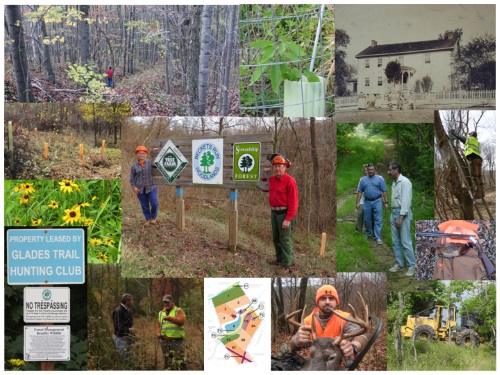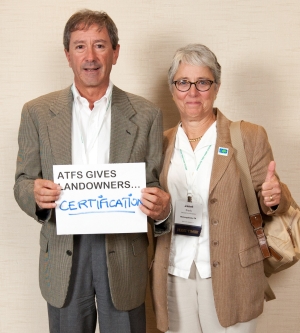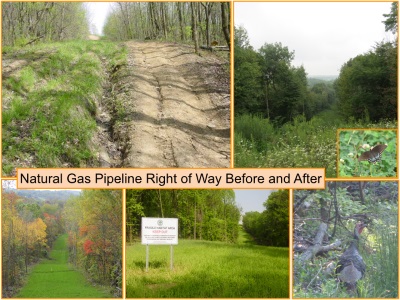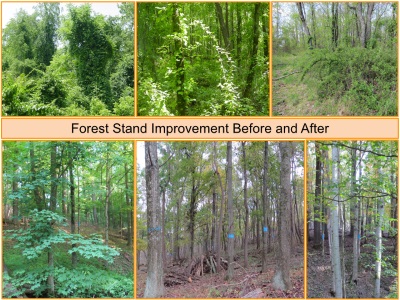Regional Tree Farmers of the Year: Raul Chiesa and Janet Sredy of Beckets Run Woodlands PA
Catch their webinar presentation here!

What makes them outstanding?
Beckets Run Woodlands is an outstanding certified ecosystem-based sustainable forestry enterprise focused on restoring and protecting the biodiversity of a severely damaged forest in the urban-wildland interface of the fourth largest city in the Northeast, a model for others to follow.
With exceptional
entrepreneurial spirit Raul Chiesa and Janet Sredy have intertwined ATFS
Certification into the enterprise using it to differentiate themselves, provide
credibility and as part of their business image. They have cleverly used ATFS
standards to commercialize natural gas development without further compromising
the forest ecosystem and to protect their property from environmentally
irresponsible actions. Furthermore, they
seek a path for financial sustainability through the commercialization of
ecosystem services  and biodiversity conservation, quality assured through
certification.
and biodiversity conservation, quality assured through
certification.
They changed the mind-set of neighbor landowners with differing objectives to reach a common ground and extend to them the enterprise’s vision. In one case, they secured an agreement from a corporate landowner to control invasive plant species in a bordering property. In another case, they established a wildlife management partnership with neighbor landowners and the Pennsylvania Game Commission to improve wildlife and game and provide recreational hunting to over 100 hunters.
And in an integrative approach to restore and protect one of the State’s Biodiversity Areas, they crafted a creative agreement with a neighbor landowner to secure ownership of rare plants at risk and assume control of the restoration. They then formed a partnership with the local university and the DCNR, assembling a program that provides biodiversity research, education and awareness.
Tree Farmer Story
The 110-acre family owned Beckets Run Woodlands Stewardship Forest is the center of an ecosystem-based certified sustainable forestry enterprise that focuses on restoring the property’s severely damaged forest, protecting biodiversity and creating a model for others to follow. Located only 20 miles south of downtown Pittsburgh, within the Beckets Run Biodiversity Area, the property exemplifies the challenges facing forest management in the urban-wildland interface.
The land, a parcel of farmland when acquired by the Sredy family in the early 1920’s, continued in agricultural use until 1948. Following the Donora steel mill environmental disaster that year, the agricultural practices were abandoned and the property turned into unattended land. Over time, the parcel suffered multiple, sequential detrimental impacts: poor agricultural practices, air pollution, abandonment, fractionated ownership, vandalism and natural gas exploitation including well and pipeline construction. As a result, a destructive process of vegetation loss, soil destabilization and erosion led to gullied land formation and infestation by invasive plant species. Trespassing ATVs and dirt bikes and illegal dumping perpetuated the process, transforming the parcel into a blighted property. Beckets Run Woodlands is surrounded by other properties in similar condition all of which are characteristic of this part of the State, some of which are part of the Beckets Run Biodiversity Area where the habitat of rare plant species continues to decline.
In 2007, after a lengthy legal process, the property ownership was finally re-consolidated. Janet Sredy, her husband Raul Chiesa and her brother and sister-in-law Mark and Patty purchased all outstanding interests in the property and became the sole owners. They then formed Beckets Run Woodlands, a Pennsylvania LLC with Raul and Janet as managers, to develop a plan for improving the property. At the time they really did not know exactly what they would do with the property, but the outdoors, wildlife and trees have always played an important role in their lives. So three weeks later they met with Pennsylvania DCNR Service Forester Mike DiRinaldo seeking forestry ideas. Mike introduced them to the USFS Forest Stewardship Program, suggested a forest management plan be written and that the property become ATFS certified.
Today, an ambitious adaptive business management Master Plan in conformance with the ATFS forest management standards is being actively implemented. The Master Plan contains embedded a Forest Stewardship Plan in partnership with USFS and Pennsylvania DCNR, a Wildlife Habitat Conservation Plan in partnership with the Pennsylvania Game Commission and a Conservation Plan in partnership with NRCS. This Master Plan is closely aligned to the land use directives dictated by the Comprehensive Development Plans of the local municipalities and Allegheny County under the Pennsylvania Municipalities Planning Code, which protect forest lands, especially those with steep slopes, biodiversity areas, stream headwaters and wildlife corridors, the very fabric of Beckets Run Woodlands.
The Master Plan includes
interconnected Forest Stewardship Initiatives and Outreach Initiatives which
address specific objectives pursued through projects or programs implemented
largely with the technical and financial resources available to private
landowners through federal, state and private agencies, with additional funding
from income generating projects such as lease hunting and from mineral
development commercialization. 
The Forest Stewardship Initiatives focus on restoring the native forest ecosystem enhancing the health of trees and wildlife and protecting biodiversity. They include the following programs: Forest and Wildlife Habitat Conservation, No-Trespassing Enforcement, White-Tailed Deer Control, Borders Beautification, Beckets Run Biodiversity Area Restoration, Roads and Trails and Funding. Timber production is regarded as a necessary ecosystem management tool and financial resource to support the conservation effort and not as an economic objective. Instead, the enterprise focuses on creating value from the conservation of a biodiverse ecosystem through certified forest management, seeking economic sustainability through the commercialization of forest services and innovative forest products and pursuing new markets such as carbon sequestration or conservation banking. All Forest Stewardship initiatives are implemented by or under the supervision of certified foresters and qualified professionals. Some initiatives extend beyond Beckets Run Woodlands and involve reaching out to other landowners, municipality officials and the community at large, defining common objectives and attaining formal collaborative agreements to accomplish them.
The main Outreach Initiatives
involve engaging people and organizations in Beckets Run Woodlands projects as
they are developed using these opportunities to extend the vision and
principles of certified ecosystem based forest management. This approach is described in the Outreach
Section along with two examples. Raul
and Janet are  passionate about certification and an article reflecting on the
values of Forest Management Certification is in press in the magazine of the
Pennsylvania Forestry Association.
Beckets Run Woodlands has an entrepreneurial spirit and is keen to
persuade other Tree Farmers to run their programs as a business. Last year, Beckets Run Woodlands contacted
representatives in Washington DC emphasizing the necessity of forestry
incentives in the Farm Bill, and contacted representatives in the State Capital
and an NPR environmental correspondent about current local issues affecting
forest land conservation. During the
spring Beckets Run Woodlands is hosting the ecology classes of California
University of Pennsylvania Environmental Studies Program and the university’s
Partners for Fish and Wildlife division will be working on the Beckets Run
Watershed Improvement Project. In the
summer Beckets Run Woodlands is organizing a tour for fellow woodland
landowners, hunters, and local public, and a workshop jointly with the
Allegheny County Conservation District for county municipal leaders.
passionate about certification and an article reflecting on the
values of Forest Management Certification is in press in the magazine of the
Pennsylvania Forestry Association.
Beckets Run Woodlands has an entrepreneurial spirit and is keen to
persuade other Tree Farmers to run their programs as a business. Last year, Beckets Run Woodlands contacted
representatives in Washington DC emphasizing the necessity of forestry
incentives in the Farm Bill, and contacted representatives in the State Capital
and an NPR environmental correspondent about current local issues affecting
forest land conservation. During the
spring Beckets Run Woodlands is hosting the ecology classes of California
University of Pennsylvania Environmental Studies Program and the university’s
Partners for Fish and Wildlife division will be working on the Beckets Run
Watershed Improvement Project. In the
summer Beckets Run Woodlands is organizing a tour for fellow woodland
landowners, hunters, and local public, and a workshop jointly with the
Allegheny County Conservation District for county municipal leaders.
Seeing the improvements in the forest over the past 8 years is very gratifying, but Beckets Run Woodlands is most proud of its outreach accomplishments with neighbors, from curtailing the blight to protecting the Beckets Run Biodiversity Area rare plants, providing exceptional recreational hunting and setting a course for recovering the ecosystem to a point where it will again sustain timber production and improve the quality of life for all.
Wood
The Master Plan addresses wood generally as part of the forest ecosystem through the implementation of forest stand improvement practices. Beckets Run Woodlands’ mixed hardwoods forest in the urban-wildland interface is severely disrupted by invasive plant species the control of which is the primary and continuous concern. An aggressive ongoing Invasive Plant Species Control Program is aimed at various species but concentrates on the severe, established, property-wide oriental bittersweet infestation. It involves a series of combined chemical (including mechanized broadcast) and mechanical methods sequentially applied in phases over a 4-year period, followed by maintenance treatments and monitoring. Given the extent of the infestation, special herbicide formulations and mechanical removal protocols had to be developed. This required pooling together technical resources from Appalachian Forest Consultants, Arborchem, Monsanto, Penn State Extension and Pennsylvania DCNR, and it became necessary to extend the treatments to a bordering property, for which an extensive formal agreement with the absentee landowner had to be procured. With some areas now reaching acceptable control levels, measures to directly improve quality and density of the native trees and control white-tailed deer are now underway.
The most important crop trees are in a 20-acre, 80-year old stand dominated by tulip poplar and oaks, in a well drained, northerly facing slope. This stand will undergo shelterwood harvest once native regeneration becomes acceptable and the certified timber market appropriate. The management of the remaining woods focuses on the stepwise release of the best trees, mainly oaks, tulip poplar, black cherry and black gum as invasives and white-tailed deer control improves. The trees felled during release are used to build brush piles for wildlife. In areas with good natural regeneration potential, selected native seedlings are pruned and protected with tree tubes to accelerate the process. Forest openings are being planted with native trees.
Water
Beckets Run Woodlands Master Plan addresses water quality, primarily, together with air quality and carbon sequestration, by improving forest health through forest stand improvement practices, which have been implemented in the entire property, and additionally, through stream improvement measures.
Beckets Run Woodlands holds the headwaters of the Beckets Run stream and one unnamed tributary, a warm water fishery running through scenic steep banks along SR136 and a municipal road within the Beckets Run Biodiversity Area. Roadside dumping into the stream banks, facilitated by its proximity to public roadways, and soil sedimentation from trespassing ATVs and dirt bikes have severely impacted the stream and its banks. Beckets Run restoration has been pursued concomitantly to other initiatives including No Trespassing Enforcement, Border Beautification and especially, the restoration of the Beckets Run Biodiversity Area because the stream banks are the delicate habitat of threatened plant species.
At the water sources and along the stream banks measures have been implemented to control invasive plants species followed by improving, and in some areas re-establishing, the riparian tree canopy by selection and release and by inter-planting fast growing native trees, especially at the headwaters. Some of the spring seeps have been converted into woodlands pools addressing together water and wildlife.
After installing specially designed no trespassing signs, no littering signs, a Beckets Run identifying sign supplied by Pennsylvania DOT, and successfully prosecuting a person for both trespassing and dumping near the stream headwaters, dumping and trespass on Beckets Run Woodlands as well as the neighboring properties within the watershed has been severely curtailed. But routine litter collection from the stream banks and roads, especially SR136 remains a necessity partly fulfilled upon request by Pennsylvania DOT litter collecting crew. The Border Beautification initiative along the roads provides a complementary approach to litter control.
Wildlife
Wildlife management in Beckets Run Woodlands (BRW) follows the prescriptions of the Wildlife Habitat Management Plan written by and under the supervision of Tammy Colt, Biodiversity Biologist, Pennsylvania Game Commission. The objective is the restoration of the forest ecosystem health and biodiversity with special attention to the habitats of threatened plant species, pollinators and game. The measures implemented include multi-step invasive and undesirable vegetation control; assisted natural regeneration; planting of native species of trees, especially mast producing, shrubs, warm season grasses and flowers; maintaining aspen stands in multi-stage early succession by cyclic clear cutting; white-tailed deer control through hunting; young tree protection; construction and installation of brush piles, woodland pools and bird and squirrel boxes. As a result the once never seen woodcock is now a frequent visitor.
BRW is within the 500 acres Beckets Run Biodiversity Area (BDA), habitat of two rare plant species protected under Pennsylvania Law. Gas development, environmentally destructive logging, trespass and vandalism have critically impacted the BDA to such extent that without action the rare plants will be lost. With no legal capacity to control plants and habitat outside BRW’s own property, protecting the BDA’s threatened plants, which are located on neighboring lands, is virtually impossible. Under the Beckets Run Biodiversity Area Restoration Program, a purchase and lease agreement was procured from a neighbor, securing the ownership of the threatened plants and a 100-year lease of the land underneath them. The agreement conveys to BRW the necessary capacity to implement and control the restoration. An ambitious monitoring and restoration plan for the rare plants is been designed in collaboration with California University of Pennsylvania Department of Biological and Environmental Sciences and Pennsylvania DCNR Ecosystem Services Section. This requires solving technical aspects of the plants’ biology and ecology, but also establishing a State plant translocation policy.
Recreation
Recreational hunting, a fully implemented initiative, integrates wildlife habitat management, no trespassing enforcement and white-tailed deer control following Quality Deer Management Association standards. Because the once eroded gas pipeline right-of-ways and forest openings created by invasive vegetation have been converted to wildlife habitat corridors supporting game, and because the area is known to produce exceptional numbers of trophy deer including State record categories, attracting recreational hunters from the Pittsburgh area and even out of state is straightforward. Lease hunting in Beckets Run Woodlands (BRW) through its private hunting club provides an important sustained income stream. Also, in partnership with neighboring landowners and the Pennsylvania Game Commission, BRW provides free recreational hunting by permit to over 100 hunters in 600 acres of neighboring lands, bringing the total area of this wildlife and game management aggregate above 1 square mile.
The Borders Beautification Initiative integrates aesthetics, forest management and outreach. The goal is to define the BRW scenic identity as perceived from the roadways that border and cross the property, and use this public perception as an outreach tool. With 6000 cars crossing the property per day, each having about one minute of visual contact with the woodlands, BRW scenic beauty along SR136 with its State bicycle trail provides an opportunity to attract sightseers, enhance the community’s quality of life and develop public appeal and bond to the stewardship forest, creating awareness of what it provides. Today, some of the trees have been pruned and forest openings near SR136 have been transformed into a savannah with wild flowers and songbirds just across from the ATF and Stewardship Forest signs. BRW is currently seeking funding and a forest landscape architect to develop a Roadside Beautification Plan using the existing trillium inhabited wooded steep slopes and the native trees.


